Identifying Spatial Matching between the Supply and Demand of Medical Resource and Accessing Carrying Capacity: A Case Study of Shenzhen, China
Abstract
:1. Introduction
2. Data and Methodology
2.1. Study Area
2.2. Data Sources
2.3. Research Methodology
2.3.1. Research Framework
2.3.2. Establishment of an Assessment Indicator System and Determination of Index Weight
2.3.3. Two-Step Floating Catchment Area Method (2SFCA)
2.3.4. Coupling Coordination Degree Method
3. Results
3.1. Analysis of the Carrying Capacity of Medical Resources in Shenzhen
3.2. Analysis of the Coordinated Development of Supply and Demand
3.3. Spatial Matching of Supply of and Demand for Medical Resources
4. Discussion
4.1. Historical Developments and Policies Influence Supply and Demand Characteristics
4.2. Rationalization of Data and Methods
4.3. Policy Recommendations for Resource Management
4.4. Limitations and Improvements for Future Research
- Expand the inclusion criteria to public hospitals, socially-run hospitals, and social recreation. The demand indicators can be further divided according to the diverse needs of residents. For example, the population could be classified by gender and age, or an in-depth investigation could be carried out in line with the changing disease spectrum, or by focusing on rehabilitation, nursing, and convalescence.
- After completing the research object, according to the carrying capacity of specific hospital points and people’s demand for medical resources, the supply and demand matching of medical resources in various regions of Shenzhen could be obtained, which would make the research results more specific and provide more scientific information for the government to reasonably plan medical resources.
- The grey relational analysis method [56] could be used to calculate the grey relational degree between each index and the carrying capacity within the two dimensions of supply and demand, so as to reveal the level of correlation between each system and reveal the key indexes affecting the carrying capacity.
- In future studies, with more data, the carrying capacity evaluation of hospitals within the hierarchy could be conducted.
5. Conclusions
- The carrying capacity and supply level of medical resources in Shenzhen showed large spatial differences. Areas that had a higher carrying capacity for medical resources were distributed in the central and southeastern regions, while a lower carrying capacity was found along the northwestern, northern, and southern edges. Hospitals with higher supply levels were distributed in the southwestern part of Shenzhen, namely, the southern part of Nanshan District, Futian District, and Luohu District. Areas with lower supply levels were situated in the western part of eastern Shenzhen. Overall, a pattern of uneven distribution was observed both inside and outside the former Special Administrative Region.
- From 1986 to 2019, the overall level of the supply of and demand for medical resources in Shenzhen increased, and the coupling coordination degree between supply and demand also continued to rise. In 2019, the coordination status of supply and demand was still on the verge of disorder until 2019, although it showed an overall trend towards coordinated development. Since 2005, the level of supply has remained slightly higher than the level of demand, which indicates that supply has continued to exceed demand.
- The spatial match between the supply of and demand for medical resources was more consistent in the central-western and eastern parts of Shenzhen, such that the clearest high-demand area was located in the central-western part of Shenzhen, which was in line with its high population density and well-developed road network.
- The four eastern administrative districts of Shenzhen (Longgang District, Yantian District, Pingshan District and Dapeng New District) were not as rich in medical resources as others, so new public hospitals should be laid out in these districts as a priority. In the low-high agglomeration area, the supply capacity of medical resources was not sufficient, so we should focus on upgrading hospitals or setting up new hospitals in this area, while maintaining the existing medical resources in the high-high agglomeration area. We might consider upgrading hospitals or building new hospitals as appropriate, and maintaining the existing level of medical resource supply in the high-low and low-low agglomeration areas.
Author Contributions
Funding
Institutional Review Board Statement
Informed Consent Statement
Data Availability Statement
Conflicts of Interest
Abbreviations
| SEZ | Shenzhen Special Economic Zone |
| TAZ | traffic analysis zone |
| OD | origin–destination |
Appendix A
| Year | Supply Level | Demand Level | Coupling Coordination Degree |
|---|---|---|---|
| 1986 | 0.00006 | 0.04449 | 0.03397 |
| 1987 | 0.00363 | 0.03852 | 0.02284 |
| 1988 | 0.00794 | 0.04217 | 0.04221 |
| 1989 | 0.01125 | 0.04074 | 0.05469 |
| 1990 | 0.01581 | 0.04916 | 0.06637 |
| 1991 | 0.02017 | 0.05471 | 0.07617 |
| 1992 | 0.02749 | 0.05901 | 0.09017 |
| 1993 | 0.03461 | 0.05714 | 0.10064 |
| 1994 | 0.04423 | 0.04831 | 0.10734 |
| 1995 | 0.05706 | 0.04843 | 0.11407 |
| 1996 | 0.08440 | 0.06226 | 0.13231 |
| 1997 | 0.08579 | 0.07100 | 0.13875 |
| 1998 | 0.08476 | 0.07944 | 0.14311 |
| 1999 | 0.08295 | 0.07791 | 0.14166 |
| 2000 | 0.08837 | 0.10519 | 0.15438 |
| 2001 | 0.09669 | 0.11519 | 0.16150 |
| 2002 | 0.10624 | 0.12597 | 0.16914 |
| 2003 | 0.12517 | 0.14829 | 0.18357 |
| 2004 | 0.13704 | 0.16085 | 0.19173 |
| 2005 | 0.15965 | 0.14344 | 0.19409 |
| 2006 | 0.23799 | 0.17372 | 0.22133 |
| 2007 | 0.24880 | 0.19829 | 0.23338 |
| 2008 | 0.26653 | 0.21562 | 0.24276 |
| 2009 | 0.28500 | 0.22655 | 0.24957 |
| 2010 | 0.29130 | 0.24446 | 0.25681 |
| 2011 | 0.31377 | 0.26554 | 0.26723 |
| 2012 | 0.34009 | 0.27403 | 0.27386 |
| 2013 | 0.37125 | 0.28319 | 0.28084 |
| 2014 | 0.39785 | 0.29095 | 0.28636 |
| 2015 | 0.43001 | 0.30514 | 0.29440 |
| 2016 | 0.47401 | 0.32848 | 0.30630 |
| 2017 | 0.50704 | 0.34517 | 0.31461 |
| 2018 | 0.54918 | 0.36179 | 0.32317 |
| 2019 | 0.59856 | 0.39110 | 0.33627 |
| Year | Health Care Institutions /pcs | Total Hospitals /pcs | Number of Beds /pcs | Licensed Doctors /Person | Registered Nurses /Person | Pharmacists /Person | Laboratory Technicians /Person | Gross Domestic Product /10,000 Yuan |
|---|---|---|---|---|---|---|---|---|
| 1986 | 297 | 32 | 2112 | 2217 | 1246 | 260 | 211 | 416,451 |
| 1987 | 311 | 34 | 2309 | 2408 | 1450 | 292 | 257 | 559,015 |
| 1988 | 308 | 35 | 2580 | 2754 | 1734 | 409 | 283 | 869,807 |
| 1989 | 332 | 35 | 2922 | 3103 | 1971 | 431 | 321 | 1,156,565 |
| 1990 | 354 | 38 | 3192 | 3426 | 2145 | 475 | 355 | 1,716,665 |
| 1991 | 360 | 41 | 3582 | 3737 | 2372 | 539 | 365 | 2,366,630 |
| 1992 | 397 | 45 | 4550 | 4247 | 2705 | 630 | 375 | 3,173,194 |
| 1993 | 400 | 45 | 5252 | 4798 | 3225 | 744 | 464 | 4,531,445 |
| 1994 | 496 | 48 | 6124 | 5347 | 3625 | 823 | 538 | 6,346,711 |
| 1995 | 506 | 63 | 6724 | 6050 | 4034 | 906 | 612 | 8,427,933 |
| 1996 | 1422 | 65 | 7455 | 7266 | 4654 | 1005 | 664 | 10,505,121 |
| 1997 | 1126 | 72 | 8288 | 7400 | 4828 | 1063 | 708 | 13,023,008 |
| 1998 | 899 | 72 | 8899 | 7191 | 5025 | 1111 | 760 | 15,449,472 |
| 1999 | 687 | 71 | 9332 | 7062 | 5230 | 1108 | 812 | 18,246,876 |
| 2000 | 683 | 72 | 10,294 | 7418 | 5425 | 1130 | 847 | 22,192,015 |
| 2001 | 723 | 75 | 11,159 | 8097 | 5945 | 1194 | 871 | 25,229,474 |
| 2002 | 761 | 77 | 12,404 | 7853 | 6635 | 1292 | 965 | 30,172,384 |
| 2003 | 893 | 85 | 13,588 | 8909 | 7321 | 1499 | 1085 | 36,401,435 |
| 2004 | 856 | 87 | 15,069 | 9846 | 7975 | 1569 | 1219 | 43,502,928 |
| 2005 | 1063 | 97 | 16,824 | 10,961 | 8981 | 1710 | 1362 | 50,357,678 |
| 2006 | 1692 | 99 | 17,553 | 16,238 | 16,583 | 2796 | 2340 | 59,206,612 |
| 2007 | 1781 | 101 | 18,086 | 17,450 | 17,869 | 2876 | 2190 | 69,252,268 |
| 2008 | 1806 | 100 | 19,913 | 18,807 | 19,339 | 2979 | 2382 | 79,414,328 |
| 2009 | 1963 | 101 | 21,399 | 19,963 | 21,008 | 3046 | 2578 | 85,144,707 |
| 2010 | 1827 | 107 | 22,842 | 20,122 | 21,866 | 2896 | 2486 | 100,690,553 |
| 2011 | 1854 | 110 | 24,079 | 21,517 | 23,987 | 3021 | 2615 | 119,228,085 |
| 2012 | 2008 | 115 | 27,984 | 22,831 | 25,931 | 3143 | 2652 | 134,962,675 |
| 2013 | 2228 | 117 | 29,261 | 24,221 | 28,035 | 3343 | 3022 | 152,342,436 |
| 2014 | 2532 | 122 | 31,042 | 25,728 | 29,723 | 3469 | 3086 | 167,953,507 |
| 2015 | 2946 | 123 | 33,771 | 27,834 | 31,717 | 3607 | 3216 | 184,368,359 |
| 2016 | 3339 | 134 | 41,512 | 29,300 | 34,065 | 3644 | 3364 | 206,857,358 |
| 2017 | 3492 | 135 | 43,868 | 31,838 | 36,389 | 3842 | 3517 | 232,802,719 |
| 2018 | 3806 | 139 | 47,551 | 34,747 | 40,309 | 4029 | 3739 | 252,660,771 |
| 2019 | 4459 | 144 | 51,318 | 38,519 | 44,273 | 4210 | 3934 | 269,270,920 |
| Year | Total Patients Treated /10,000 Persons | Total Inpatients /10,000 Persons | Utilization Rate of Beds (%) | Turnover of Beds (Time) | Year-end Permanent Population /10,000 Persons | Hospital Beds per 1000 Persons/pcs | Physicians per 1000 Persons/pcs | Per Capita Disposable Income of Residents /10,000 Yuan |
|---|---|---|---|---|---|---|---|---|
| 1986 | 389 | 4.68 | 66.2 | 24.4 | 93.56 | 2.26 | 2.37 | 0.1817 |
| 1987 | 461 | 5.84 | 73.6 | 22.2 | 105.44 | 2.00 | 2.09 | 0.2091 |
| 1988 | 563 | 6.97 | 75.6 | 28.8 | 120.14 | 1.68 | 1.80 | 0.2569 |
| 1989 | 607 | 7.87 | 78.4 | 29 | 141.6 | 1.53 | 1.62 | 0.3657 |
| 1990 | 729 | 8.73 | 81.4 | 29 | 167.78 | 1.58 | 1.70 | 0.4127 |
| 1991 | 840 | 10.08 | 85.2 | 30.3 | 226.76 | 1.50 | 1.57 | 0.4564 |
| 1992 | 976 | 11.4 | 81.9 | 28 | 268.02 | 1.74 | 1.63 | 0.7737 |
| 1993 | 1050 | 12.59 | 80.3 | 26.6 | 335.97 | 1.78 | 1.63 | 0.5783 |
| 1994 | 1057 | 12.81 | 70.8 | 23.2 | 412.71 | 1.83 | 1.59 | 1.0503 |
| 1995 | 1202 | 13.07 | 65 | 20.8 | 449.15 | 1.95 | 1.75 | 1.2771 |
| 1996 | 1168 | 14.63 | 64.3 | 21.5 | 482.89 | 2.08 | 2.03 | 1.6296 |
| 1997 | 1231 | 16.15 | 67.4 | 21.9 | 527.75 | 2.18 | 1.95 | 1.8579 |
| 1998 | 1386 | 19.05 | 68.6 | 24.1 | 580.33 | 2.25 | 1.82 | 1.9214 |
| 1999 | 1520 | 21.12 | 69.3 | 24.5 | 632.56 | 2.30 | 1.74 | 1.252 |
| 2000 | 1699 | 26.61 | 75.4 | 28.3 | 701.24 | 2.38 | 1.71 | 2.0906 |
| 2001 | 1912 | 30.23 | 77.3 | 29.4 | 724.57 | 2.38 | 1.73 | 2.276 |
| 2002 | 2062 | 35.74 | 80 | 30.6 | 746.62 | 2.46 | 1.64 | 2.4941 |
| 2003 | 3052 | 41.57 | 84 | 33.5 | 778.27 | 2.44 | 1.69 | 2.5936 |
| 2004 | 3514 | 49 | 82.4 | 34.9 | 800.8 | 2.52 | 1.73 | 2.7596 |
| 2005 | 4055 | 54.68 | 79.9 | 34.6 | 827.75 | 2.03 | 1.40 | 2.1494 |
| 2006 | 5170 | 59.24 | 81.6 | 35.6 | 871.1 | 2.02 | 2.02 | 2.2567 |
| 2007 | 5954 | 68.09 | 87.5 | 38.6 | 912.37 | 1.98 | 2.06 | 2.4301 |
| 2008 | 6842 | 75.34 | 89.1 | 37.9 | 954.28 | 2.09 | 2.11 | 2.6729 |
| 2009 | 7549 | 79.7 | 86.1 | 38.4 | 995.01 | 2.15 | 2.15 | 2.9245 |
| 2010 | 8127 | 89.1 | 89.2 | 40.1 | 1037.2 | 2.2 | 2.05 | 3.2381 |
| 2011 | 8878 | 96.2 | 90.5 | 41.4 | 1046.74 | 2.3 | 2.16 | 3.6505 |
| 2012 | 8638 | 105.4 | 85.8 | 40.1 | 1054.74 | 2.65 | 2.27 | 4.0742 |
| 2013 | 9112 | 109.4 | 84.2 | 38.4 | 1062.89 | 2.75 | 2.39 | 4.4653 |
| 2014 | 8853 | 119.4 | 85.5 | 39.4 | 1077.89 | 2.88 | 2.49 | 4.0948 |
| 2015 | 8901 | 124.1 | 84 | 38.1 | 1137.87 | 3.35 | 2.55 | 4.4633 |
| 2016 | 9598 | 138.4 | 85.2 | 39 | 1190.84 | 3.49 | 2.57 | 4.8695 |
| 2017 | 9960 | 150.8 | 84.8 | 39.3 | 1252.83 | 3.5 | 2.66 | 5.2938 |
| 2018 | 9986 | 162 | 84 | 39.6 | 1302.66 | 3.65 | 2.79 | 5.7544 |
| 2019 | 10,812 | 182.2 | 82.5 | 40.1 | 1343.88 | 3.83 | 3.01 | 6.2522 |
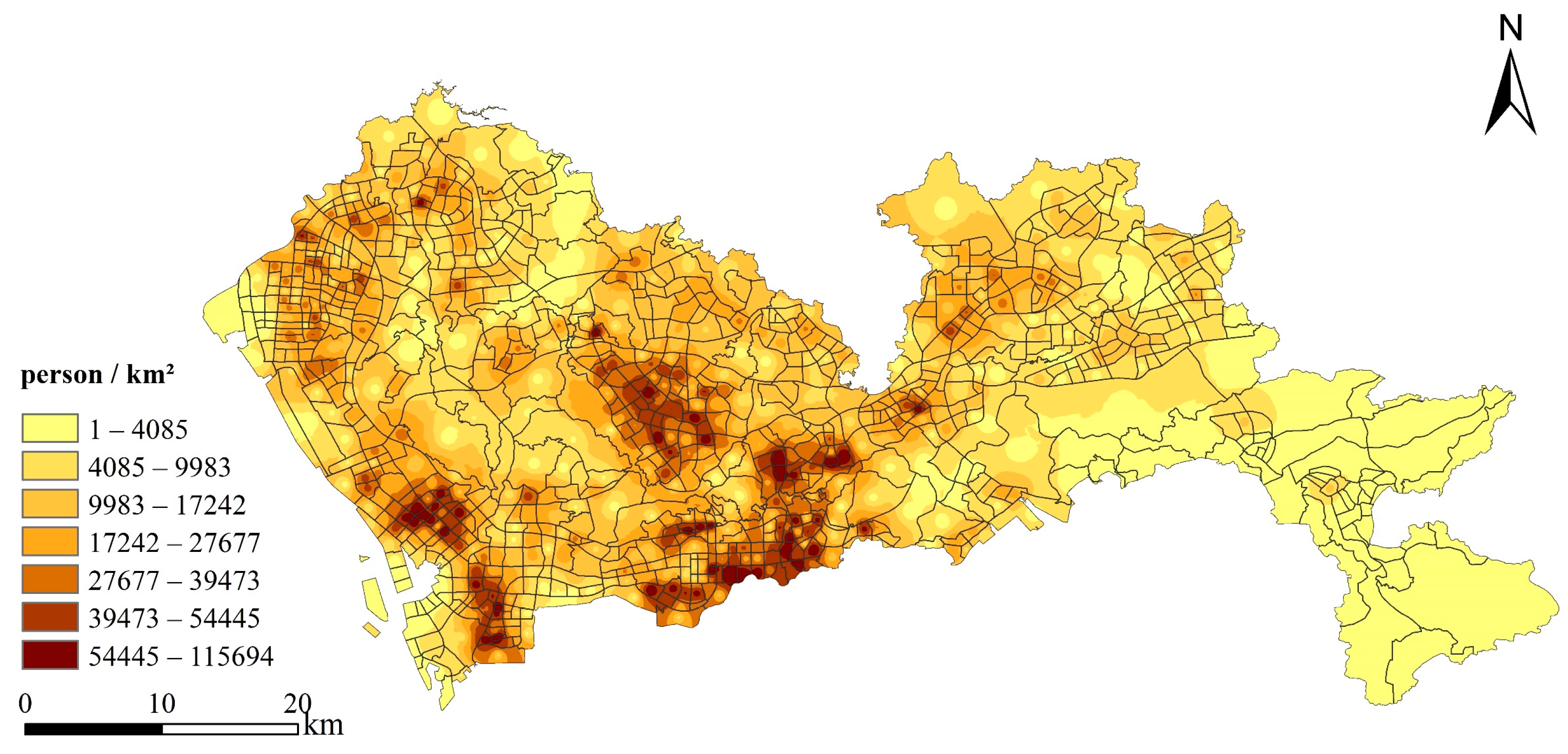

| Specific Vocabulary | Explanation |
|---|---|
| Community Health Centers | To integrate urban healthcare resources, China began to construct a two-level healthcare system consisting of tertiary hospitals (large general hospitals) and community health centers in 1997 [57]. Community health centers refer to the health care activities of prevention, medical treatment, rehabilitation, and health promotion provided by health and related departments to residents in a certain community. They also play an important role in primary health screening and management globally in defending against the 2019 novel coronavirus (COVID-19) [58]. |
| Pilot Demonstration Area of Socialism with Chinese Characteristics | The Central Committee of the Communist Party of China and the State Council issued relevant documents in August 2019, elevating Shenzhen to the strategic status of being a model city for the rule of law in China, among the top global cities, and a city example for building a strong, modern, socialist state in China [59]. |
References
- Bekemeier, B.; Park, S.; Whitman, G. Challenges and lessons learned in promoting adoption of standardized local public health service delivery data through the application of the Public Health Activities and Services Tracking model. J. Am. Med. Inform. Assoc. 2019, 26, 1660–1663. [Google Scholar] [CrossRef] [PubMed]
- Li, M.; Kwan, M.-P.; Chen, J.; Wang, J.; Yin, J.; Yu, D. Measuring emergency medical service (EMS) accessibility with the effect of city dynamics in a 100-year pluvial flood scenario. Cities 2021, 117, 103314. [Google Scholar] [CrossRef]
- Zhou, Z.; Zhao, Y.; Shen, C.; Lai, S.; Nawaz, R.; Gao, J. Evaluating the effect of hierarchical medical system on health seeking behavior: A difference-in-differences analysis in China. Soc. Sci. Med. 2020, 268, 113372. [Google Scholar] [CrossRef] [PubMed]
- Wang, X.; Li, Q.; Sun, X.; He, S.; Xia, F.; Song, P.; Shao, Y.; Wu, J.; Cheke, R.A.; Tang, S.; et al. Effects of medical resource capacities and intensities of public mitigation measures on outcomes of COVID-19 outbreaks. BMC Public Health 2021, 21, 1–11. [Google Scholar] [CrossRef] [PubMed]
- Cai, Y.; Kwek, S.; Tang, S.S.L.; Saffari, S.E.; Lum, E.; Yoon, S.; Ansah, J.P.; Matchar, D.B.; Kwa, A.L.; Ang, K.A.; et al. Impact of the COVID-19 pandemic on a tertiary care public hospital in Singapore: Resources and economic costs. J. Hosp. Infect. 2022, 121, 1–8. [Google Scholar] [CrossRef]
- Ouyang, W.; Wang, B.; Tian, L.; Niu, X. Spatial deprivation of urban public services in migrant enclaves under the context of a rapidly urbanizing China: An evaluation based on suburban Shanghai. Cities 2017, 60, 436–445. [Google Scholar] [CrossRef]
- Yao, Q.; Liu, C.; Sun, J. Inequality in Health Services for Internal Migrants in China: A National Cross-Sectional Study on the Role of Fund Location of Social Health Insurance. Int. J. Environ. Res. Public Health 2020, 17, 6327. [Google Scholar] [CrossRef]
- Zhou, M.; Zhao, S.; Fu, M. Supply-induced demand for medical services under price regulation: Evidence from hospital expansion in China. China Econ. Rev. 2021, 68, 101642. [Google Scholar] [CrossRef]
- Di, X.; Wang, L.; Dai, X.; Yang, L. Assessing the Accessibility of Home-Based Healthcare Services for the Elderly: A Case from Shaanxi Province, China. Int. J. Environ. Res. Public Health 2020, 17, 7168. [Google Scholar] [CrossRef]
- Jiang, J.; Yuan, Y.; Bai, X.; Yan, M.; Li, Y. Study on key healthcare resources allocation in COVID-19 pandemic control: Case study of Wuhan city in Hubei province. Chin. J. Hosp. Administration 2020, 36, 804–809. (In Chinese) [Google Scholar]
- Song, C.; Wang, Y.; Yang, X.; Yang, Y.; Tang, Z.; Wang, X.; Pan, J. Spatial and Temporal Impacts of Socioeconomic and Environmental Factors on Healthcare Resources: A County-Level Bayesian Local Spatiotemporal Regression Modeling Study of Hospital Beds in Southwest China. Int. J. Environ. Res. Public Health 2020, 17, 5890. [Google Scholar] [CrossRef] [PubMed]
- Langford, M.; Higgs, G.; Fry, R. Multi-modal two-step floating catchment area analysis of primary health care accessibility. Health Place 2016, 38, 70–81. [Google Scholar] [CrossRef] [PubMed]
- Xia, T.; Song, X.; Zhang, H.; Song, X.; Kanasugi, H.; Shibasaki, R. Measuring spatio-temporal accessibility to emergency medical services through big GPS data. Health Place 2019, 56, 53–62. [Google Scholar] [CrossRef]
- Xia, D.; Wang, B.; Li, Y.; Rong, Z.; Zhang, Z. An Efficient MapReduce-Based Parallel Clustering Algorithm for Distributed Traffic Subarea Division. Discret. Dyn. Nat. Soc. 2015, 2015, 793010. [Google Scholar] [CrossRef] [Green Version]
- Yin, C.; He, Q.; Liu, Y.; Chen, W.; Gao, Y. Inequality of public health and its role in spatial accessibility to medical facilities in China. Appl. Geogr. 2018, 92, 50–62. [Google Scholar] [CrossRef]
- Lu, C.; Zhang, Z.; Lan, X. Impact of China’s referral reform on the equity and spatial accessibility of healthcare resources: A case study of Beijing. Soc. Sci. Med. 2019, 235, 112386. [Google Scholar] [CrossRef] [PubMed]
- Kanuganti, S.; Sarkar, A.K.; Singh, A.P. Evaluation of access to health care in rural areas using enhanced two-step floating catchment area (E2SFCA) method. J. Transp. Geogr. 2016, 56, 45–52. [Google Scholar] [CrossRef]
- Bednarski, B.P.; Singh, A.D.; Jones, W.M. On collaborative reinforcement learning to optimize the redistribution of critical medical supplies throughout the COVID-19 pandemic. J. Am. Med. Inform. Assoc. 2020, 28, 874–878. [Google Scholar] [CrossRef]
- Higgs, G.; Zahnow, R.; Corcoran, J.; Langford, M.; Fry, R. Modelling spatial access to General Practitioner surgeries: Does public transport availability matter? J. Transp. Health 2017, 6, 143–154. [Google Scholar] [CrossRef]
- Zhou, Z.; Xu, Z.; Liu, A.; Zhou, S.; Mu, L.; Zhang, X. Mapping the Accessibility of Medical Facilities of Wuhan during the COVID-19 Pandemic. ISPRS Int. J. Geo-Inf. 2021, 10, 318. [Google Scholar] [CrossRef]
- Cheng, G.; Zeng, X.; Duan, L.; Lu, X.; Sun, H.; Jiang, T.; Li, Y. Spatial difference analysis for accessibility to high level hospitals based on travel time in Shenzhen, China. Habitat Int. 2016, 53, 485–494. [Google Scholar] [CrossRef] [Green Version]
- Hu, W.; Li, L.; Su, M. Spatial Inequity of Multi-Level Healthcare Services in a Rapid Expanding Immigrant City of China: A Case Study of Shenzhen. Int. J. Environ. Res. Public Health 2019, 16, 3441. [Google Scholar] [CrossRef] [PubMed] [Green Version]
- Bing, Z.; Qiu, Y.; Huang, H.; Chen, T.; Zhong, W.; Jiang, H. Spatial distribution of cultural ecosystem services demand and supply in urban and suburban areas: A case study from Shanghai, China. Ecol. Indic. 2021, 127, 107720. [Google Scholar] [CrossRef]
- Wang, C.; Li, Y.; Myint, S.W.; Zhao, Q.; Wentz, E.A. Impacts of spatial clustering of urban land cover on land surface temperature across Köppen climate zones in the contiguous United States. Landsc. Urban Plan. 2019, 192, 103668. [Google Scholar] [CrossRef]
- Baró, F.; Gómez-Baggethun, E.; Haase, D. Ecosystem service bundles along the urban-rural gradient: Insights for landscape planning and management. Ecosyst. Serv. 2017, 24, 147–159. [Google Scholar] [CrossRef] [Green Version]
- Karimi, J.D.; Corstanje, R.; Harris, J.A. Bundling ecosystem services at a high resolution in the UK: Trade-offs and synergies in urban landscapes. Landsc. Ecol. 2021, 36, 1817–1835. [Google Scholar] [CrossRef]
- Liu, F.; Deng, Y. Determine the Number of Unknown Targets in Open World Based on Elbow Method. IEEE Trans. Fuzzy Syst. 2020, 29, 986–995. [Google Scholar] [CrossRef]
- Zhang, Y.; Moges, S.; Block, P. Optimal Cluster Analysis for Objective Regionalization of Seasonal Precipitation in Regions of High Spatial–Temporal Variability: Application to Western Ethiopia. J. Clim. 2016, 29, 3697–3717. [Google Scholar] [CrossRef]
- Cai, J.; Li, X.; Liu, L.; Chen, Y.; Wang, X.; Lu, S. Coupling and coordinated development of new urbanization and agro-ecological environment in China. Sci. Total Environ. 2021, 776, 145837. [Google Scholar] [CrossRef]
- Zhang, D.; Chen, Y. Evaluation on urban environmental sustainability and coupling coordination among its dimensions: A case study of Shandong Province, China. Sustain. Cities Soc. 2021, 75, 103351. [Google Scholar] [CrossRef]
- Gao, P.; Wang, X.; Wang, H.; Cheng, C. Viewpoint: A correction to the entropy weight coefficient method by Shen et al. for accessing urban sustainability [Cities 42 (2015) 186–194]. Cities 2020, 103, 102742. [Google Scholar] [CrossRef]
- Xing, L.; Liu, Y.; Wang, B.; Wang, Y.; Liu, H. An environmental justice study on spatial access to parks for youth by using an improved 2SFCA method in Wuhan, China. Cities 2019, 96, 102405. [Google Scholar] [CrossRef]
- Zhang, F.; Li, D.; Ahrentzen, S.; Zhang, J. Assessing spatial disparities of accessibility to community-based service resources for Chinese older adults based on travel behavior: A city-wide study of Nanjing, China. Habitat Int. 2019, 88, 101984. [Google Scholar] [CrossRef]
- Guo, Y.; Fu, B.; Wang, Y.; Xu, P.; Liu, Q. Identifying spatial mismatches between the supply and demand of recreation services for sustainable urban river management: A case study of Jinjiang River in Chengdu, China. Sustain. Cities Soc. 2021, 77, 103547. [Google Scholar] [CrossRef]
- Tong, D.; Gao, J.; Gong, Y. Impact of Urban Village on Job-Housing Balance in Shenzhen: A Study Using Mobile Phone Signaling Data. Acta Sci. Nat. Univ. Pekinensis. 2020, 56, 1091–1101. (In Chinese) [Google Scholar]
- Lee, J.; Yasmin, S.; Eluru, N.; Abdel-Aty, M.; Cai, Q. Analysis of crash proportion by vehicle type at traffic analysis zone level: A mixed fractional split multinomial logit modeling approach with spatial effects. Accid. Anal. Prev. 2018, 111, 12–22. [Google Scholar] [CrossRef]
- Huang, Q.; Yang, Y.; Xu, Y.; Yang, F.; Yuan, Z.; Sun, Y. Citywide road-network traffic monitoring using large-scale mobile signaling data. Neurocomputing 2021, 444, 136–146. [Google Scholar] [CrossRef]
- Tong, D.; Sun, Y.; Xie, M. Evaluation of green space accessibility based on improved Gaussian two-step floating catchment area method: A case study of Shenzhen City, China. Prog. Geogr. 2021, 40, 1113–1126. [Google Scholar] [CrossRef]
- Zhao, Y.; Wang, N.; Luo, Y.; He, H.; Wu, L.; Wang, H.; Wang, Q.; Wu, J. Quantification of ecosystem services supply-demand and the impact of demographic change on cultural services in Shenzhen, China. J. Environ. Manag. 2021, 304, 114280. [Google Scholar] [CrossRef]
- Benevenuto, R.; Caulfield, B. Measuring access to urban centres in rural Northeast Brazil: A spatial accessibility poverty index. J. Transp. Geogr. 2019, 82, 102553. [Google Scholar] [CrossRef]
- Zhao, D.; Xu, J.; Gao, S.; Xu, H. Spatial Social Benefit Evaluation of Sponge Parks’ Green Space Based on Improved Two-Step Floating Catchment Accessibility Modeling: A Case Study of Pilot Area of Sponge City Construction in Zhenjiang. Ecol. Econ. 2020, 36, 221–227. (In Chinese) [Google Scholar]
- Chen, J.; Li, Z.; Dong, Y.; Song, M.; Shahbaz, M.; Xie, Q. Coupling coordination between carbon emissions and the eco-environment in China. J. Clean. Prod. 2020, 276, 123848. [Google Scholar] [CrossRef]
- Tomal, M. Evaluation of coupling coordination degree and convergence behaviour of local development: A spatiotemporal analysis of all Polish municipalities over the period 2003–2019. Sustain. Cities Soc. 2021, 71, 102992. [Google Scholar] [CrossRef]
- Song, Q.; Zhou, N.; Liu, T.; Siehr, S.A.; Qi, Y. Investigation of a “coupling model” of coordination between low-carbon development and urbanization in China. Energy Policy 2018, 121, 346–354. [Google Scholar] [CrossRef] [Green Version]
- Fan, L.H.; Lin, X.Q.; Wang, S. Spatial-temporal succession characteristics of public service facilities supply and demand coordinated development in Beijing: A case study of educational and medical facilities. Hum. Geogr. 2015, 30, 90–97. (In Chinese) [Google Scholar]
- Xiao, Y.; Tian, K.; Huang, H.; Wang, J.; Zhou, T. Coupling and coordination of socioeconomic and ecological environment in Wenchuan earthquake disaster areas: Case study of severely affected counties in southwestern China. Sustain. Cities Soc. 2021, 71, 102958. [Google Scholar] [CrossRef]
- Zuo, Z.; Guo, H.; Cheng, J.; Li, Y. How to achieve new progress in ecological civilization construction? – Based on cloud model and coupling coordination degree model. Ecol. Indic. 2021, 127, 107789. [Google Scholar] [CrossRef]
- Zhao, M.; Zhou, F.; Lu, X.; Wang, W.; Lu, J. Spatio-temporal Characteristics of Tourism Flow in Jinzhou City Based on Wavelet Analysis. Areal Res. Dev. 2019, 38, 84–88. (In Chinese) [Google Scholar]
- Liu, H.; Jiang, S.; Jin, J.; Li, J.; Zhou, Y.; Li, L. A GIS-based Approach to Regional Drought Risk Zoning. J. Catastrophology 2013, 28, 198–203. (In Chinese) [Google Scholar]
- Zhu, L.; Zhong, S.; Tu, W.; Zheng, J.; He, S.; Bao, J.; Huang, C. Assessing Spatial Accessibility to Medical Resources at the Community Level in Shenzhen, China. Int. J. Environ. Res. Public Health 2019, 16, 242. [Google Scholar] [CrossRef] [Green Version]
- Tao, Z.; Cheng, Y.; Liu, J. Hierarchical two-step floating catchment area (2SFCA) method: Measuring the spatial accessibility to hierarchical healthcare facilities in Shenzhen, China. Int. J. Equity Health 2020, 19, 1–16. [Google Scholar] [CrossRef] [PubMed]
- Tao, Z.; Yao, Z.; Kong, H.; Duan, F.; Zhuolin, T. Spatial accessibility to healthcare services in Shenzhen, China: Improving the multi-modal two-step floating catchment area method by estimating travel time via online map APIs. BMC Health Serv. Res. 2018, 18, 345. [Google Scholar] [CrossRef] [Green Version]
- Zhang, F.; Hu, L. Research on resilience improvement strategies for medical care and epidemic prevention: A case study on medical facilities in Beijing. City Plan. Rev. 2020, 44, 9–14. (In Chinese) [Google Scholar]
- Li, C.; Luo, L.; Zhou, H.; Fang, T.; Zeng, B.; Yang, X. Reformand practice of public health system in Shenzhen under the background of Healthy China Strategy. Chin. J. HP. 2019, 12, 20–24. (In Chinese) [Google Scholar]
- Chen, B.Y.; Cheng, X.-P.; Kwan, M.-P.; Schwanen, T. Evaluating spatial accessibility to healthcare services under travel time uncertainty: A reliability-based floating catchment area approach. J. Transp. Geogr. 2020, 87, 102794. [Google Scholar] [CrossRef]
- Hu, Z.; Yang, X.; Yang, J.; Yuan, J.; Zhang, Z. Linking landscape pattern, ecosystem service value, and human well-being in Xishuangbanna, southwest China: Insights from a coupling coordination model. Glob. Ecol. Conserv. 2021, 27, e01583. [Google Scholar] [CrossRef]
- Liu, R.; Shi, L.; Meng, Y.; He, N.; Wu, J.; Yan, X.; Hu, R. The institutional primary healthcare service quality and patients’ experiences in Chinese community health centres: Results from the Greater Bay Area study, China. Int. J. Equity Health 2021, 20, 1–9. [Google Scholar] [CrossRef]
- Xu, J.; Pan, R.; Pong, R.W.; Miao, Y.; Qian, D. Different Models of Hospital–Community Health Centre Collaboration in Selected Cities in China: A Cross-Sectional Comparative Study. Int. J. Integr. Care 2016, 16, 8. [Google Scholar] [CrossRef] [Green Version]
- Zhou, P.X.; Feng, Z.H. Logic and the Legislative Approach for Shenzhen to Build a Pilot Demonstration Area of Socialism with Chinese Characteristics. J. Shenzhen Univ. (Humanit. Soc. Sci.) 2020, 37, 34–45. (In Chinese) [Google Scholar]
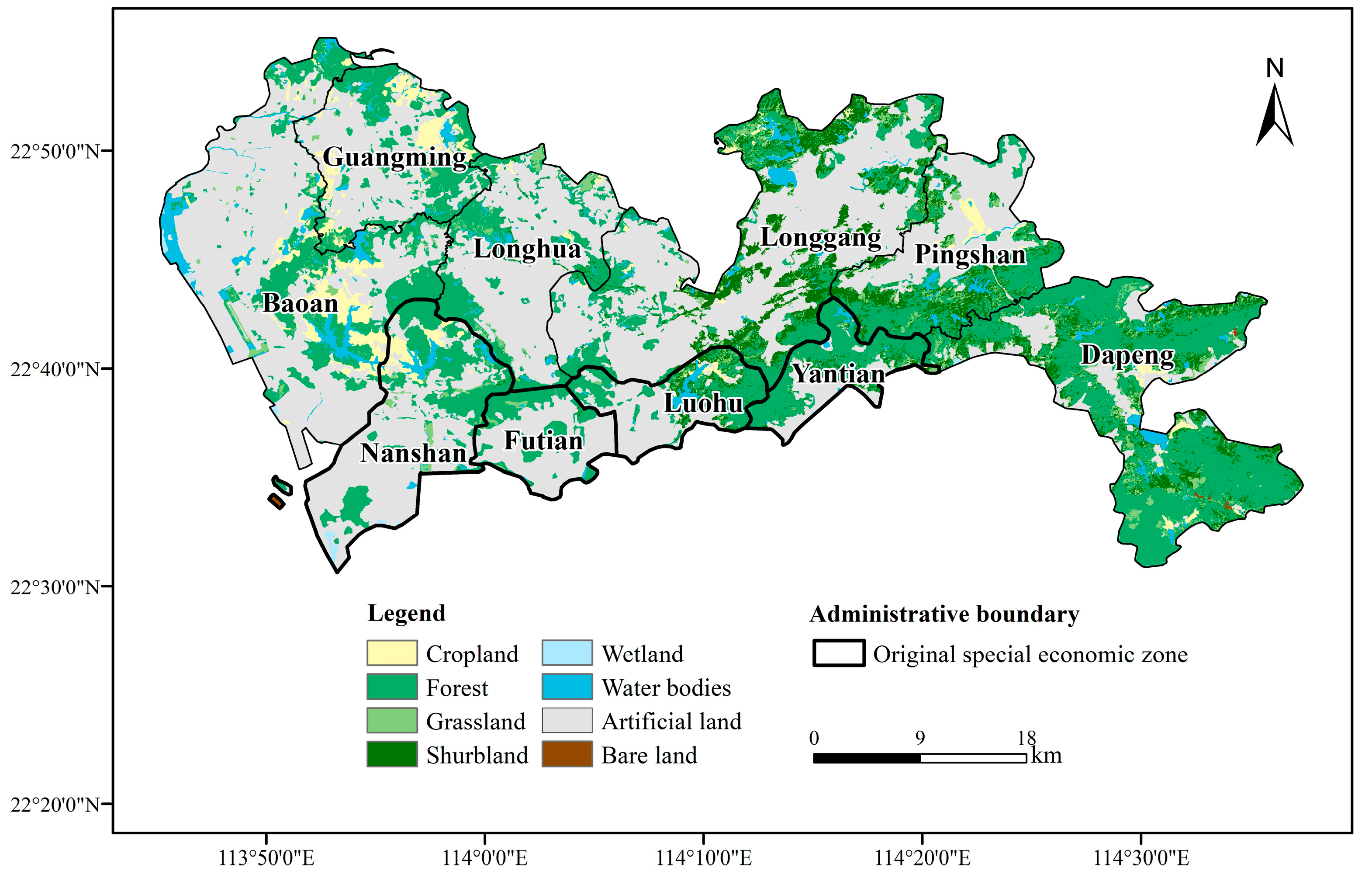
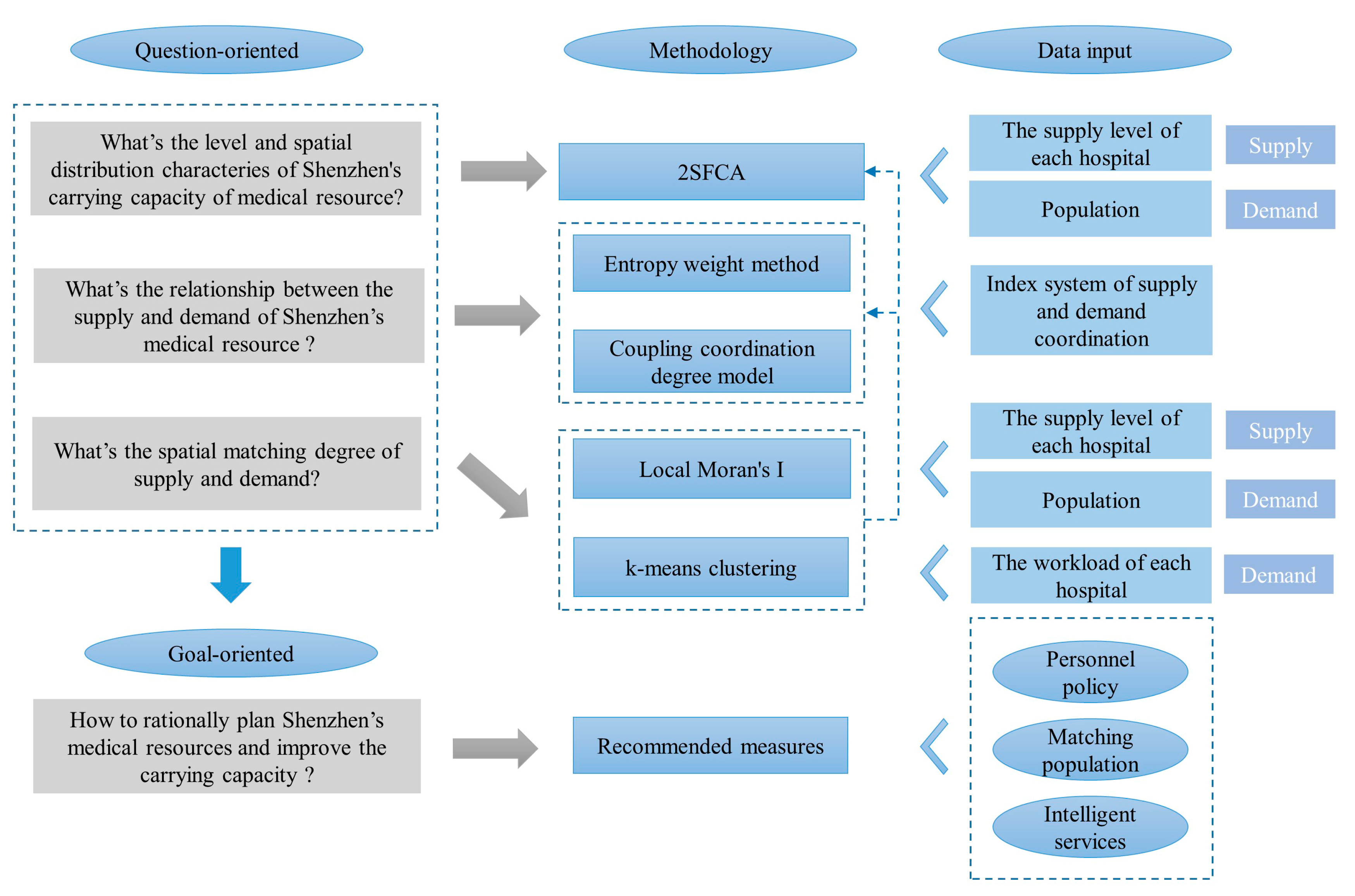
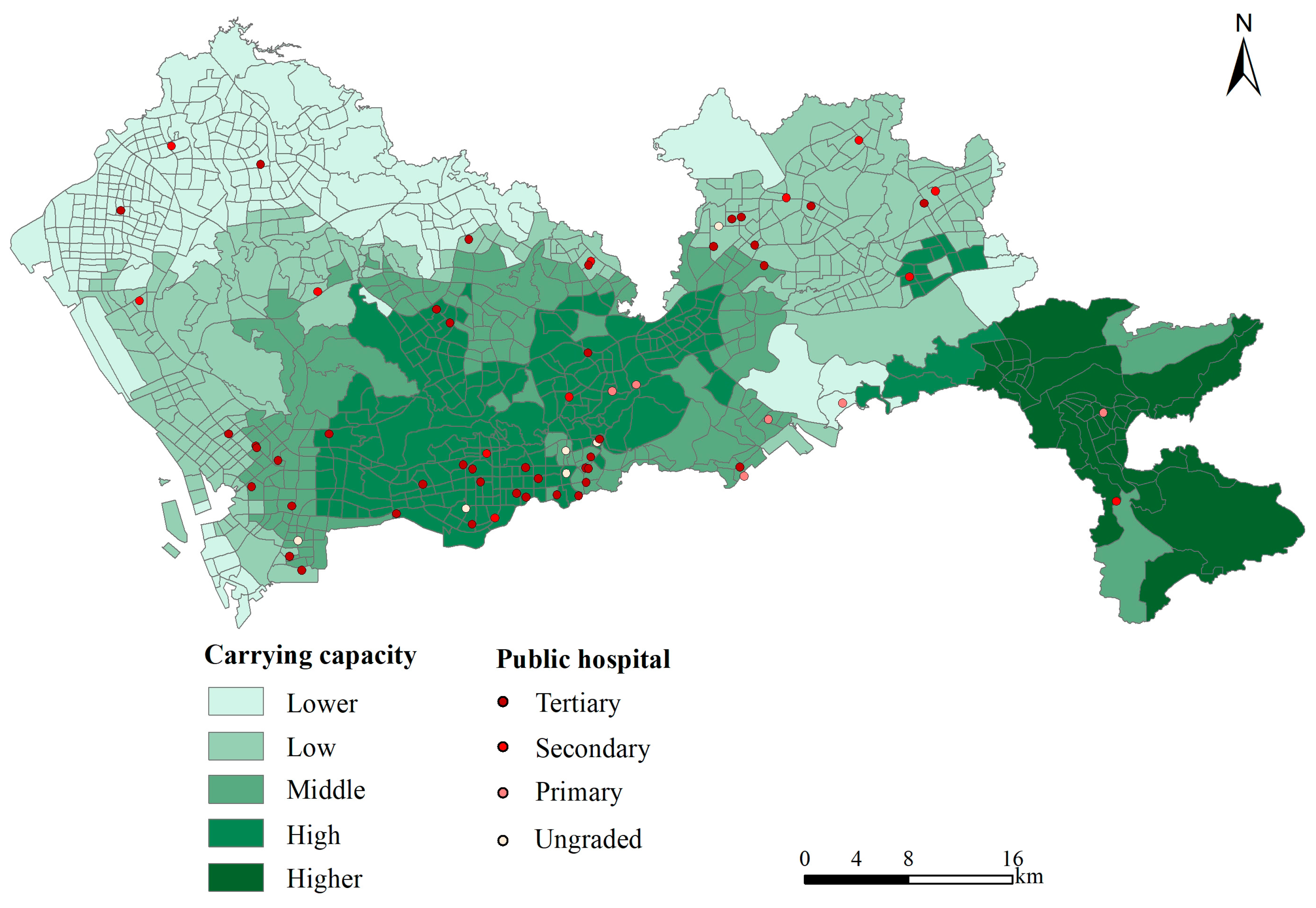
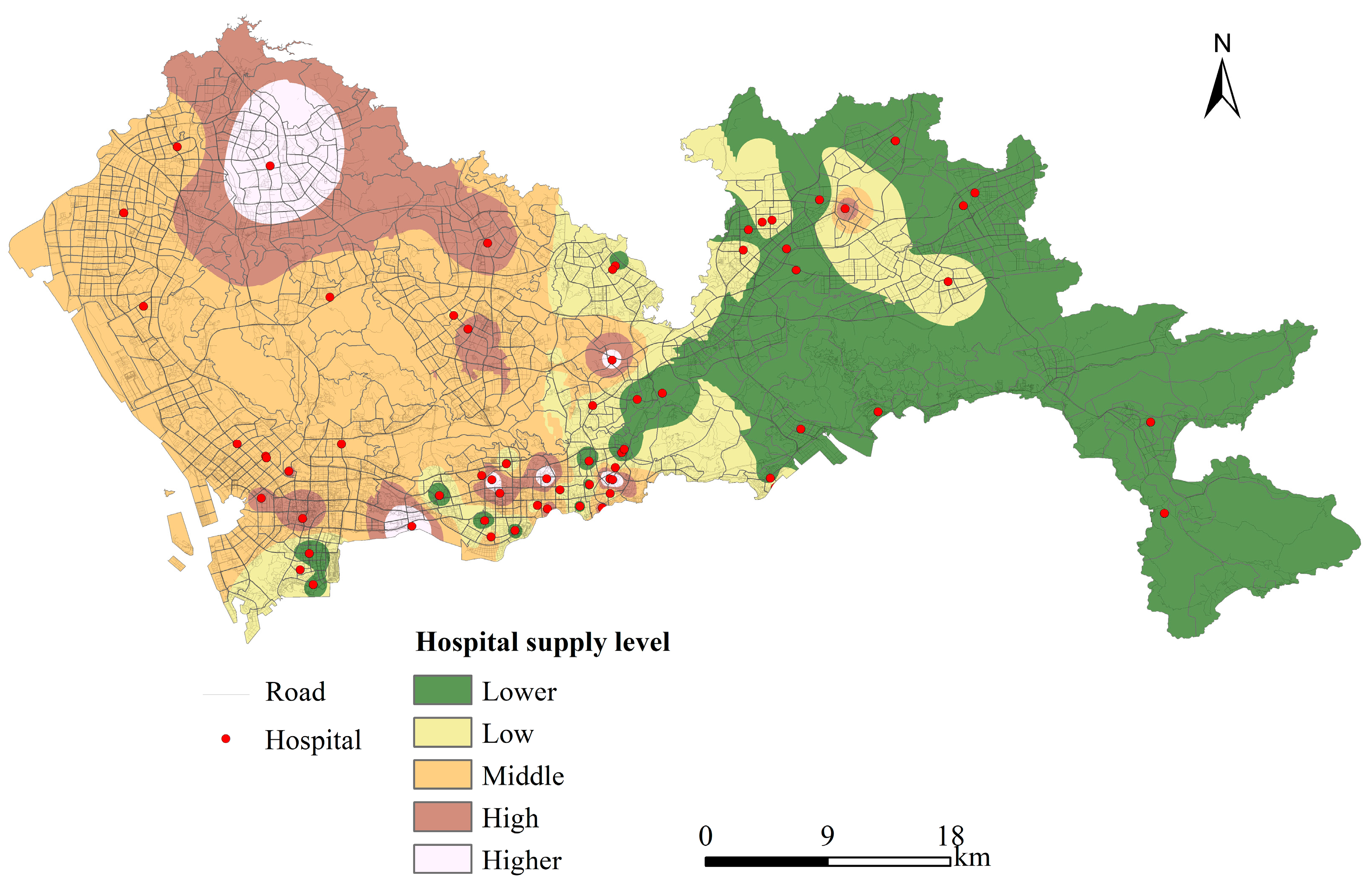
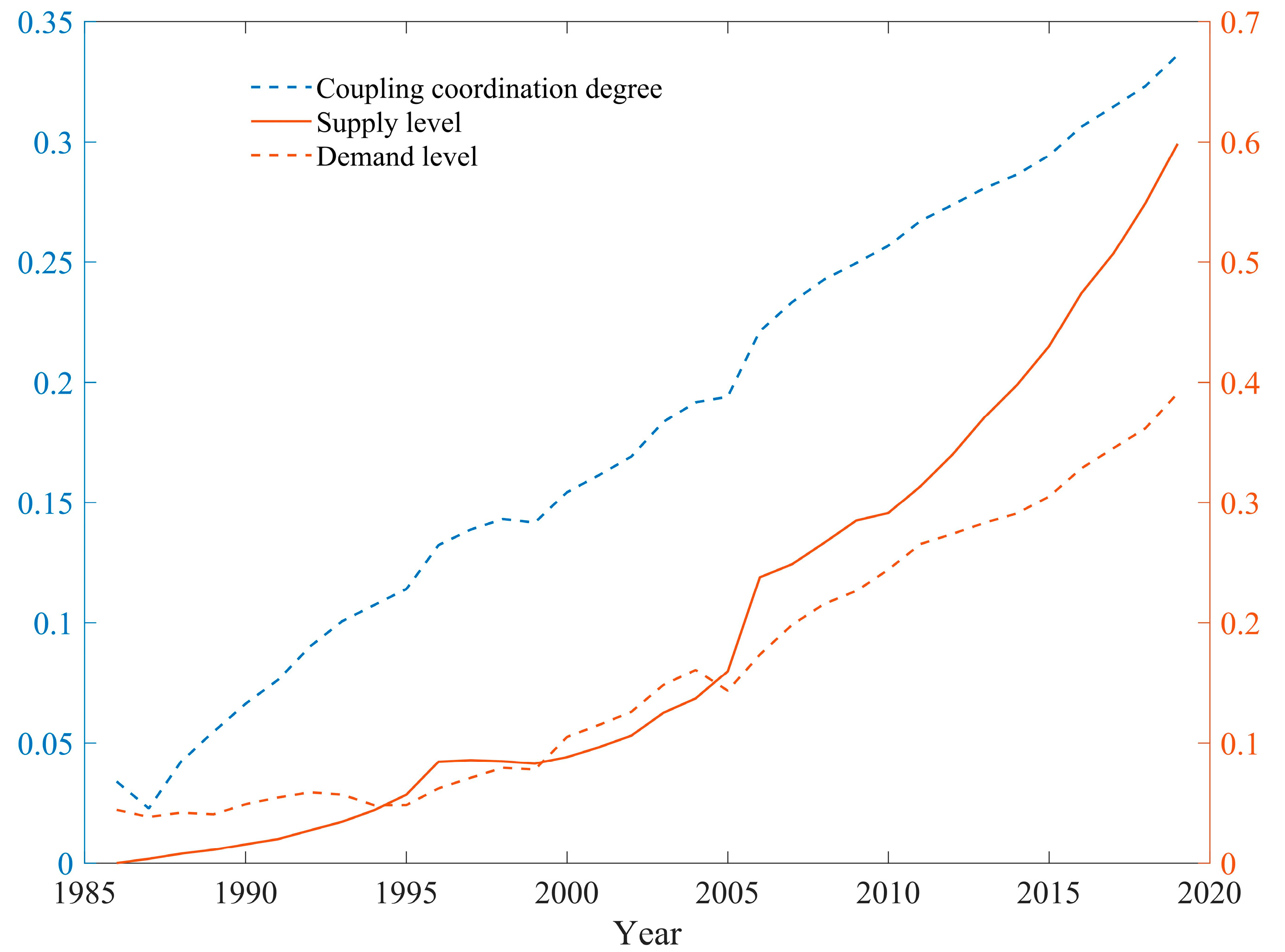
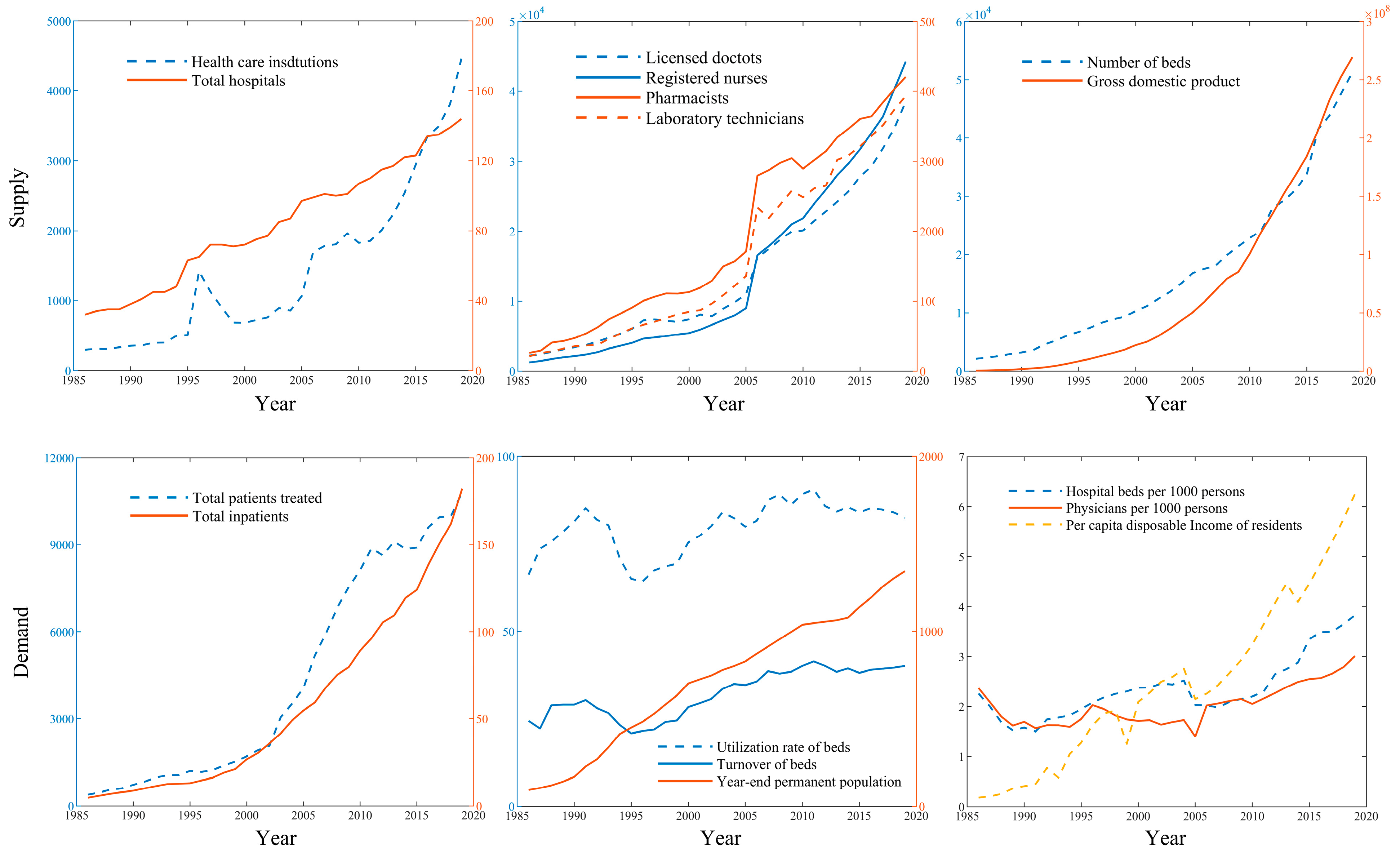
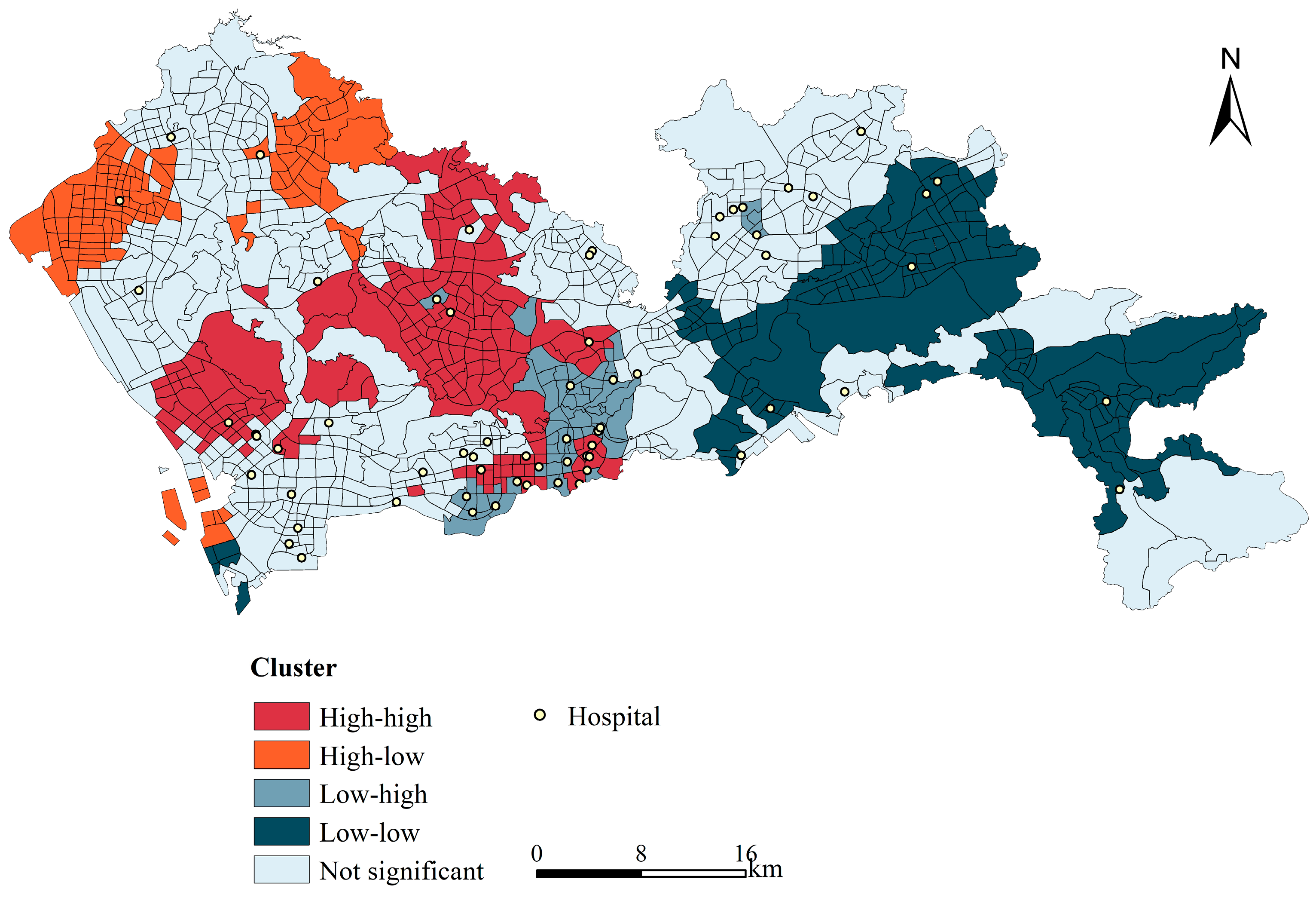

| Element Layer | Factor Level | Weight | Index Attribute |
|---|---|---|---|
| Supply level | Health care institutions (pcs) | 0.0842 | Positive |
| Total hospitals (pcs) | 0.0454 | Positive | |
| The number of beds (pcs) | 0.0725 | Positive | |
| Licensed doctors (pcs) | 0.0712 | Positive | |
| Registered nurses (person) | 0.0882 | Positive | |
| Pharmacists (person) | 0.0570 | Positive | |
| Laboratory technicians (person) | 0.0705 | Positive | |
| Gross domestic product (10,000 yuan) | 0.1095 | Positive | |
| Demand level | Total patients treated (10,000 persons) | 0.0805 | Positive |
| Total inpatients (10,000 persons) | 0.0837 | Positive | |
| Utilization rate of beds (%) | 0.0265 | Positive | |
| Turnover of beds (time) | 0.0370 | Positive | |
| Year-end permanent population (10,000 persons) | 0.0402 | Positive | |
| Hospital beds per 1000 persons (pcs) | 0.0444 | Positive | |
| Physicians per 1000 persons (person) | 0.0360 | Positive | |
| Hospital beds per 1000 persons (pcs) | 0.0533 | Positive | |
| Per capita disposable income (10,000 yuan) | 0.0842 | Positive |
| Geographic Model | Calculation Formula | Model Interpretation | Meaning |
|---|---|---|---|
| Coordination degree of supply and demand level | C represents the coupling degree. k is the adjustment coefficient, the study takes k = 2 [44]. | The larger C, the better the coupling between supply and demand. | |
| Comprehensive evaluation index | T represents the comprehensive evaluation index to reflect the level of supply and demand level of medical resources; α and β are undetermined coefficients. | T reflects the overall level of medical resources. When supply is as important as the demand coefficient, the study takes α = β = 0.5. | |
| Coupling coordination degree method | D is the CCD between supply and EE, and the value of D is between 0 and 1. | The larger the value of D, the more harmonious the coupling relationship between the supply and demand. |
| Coupling Coordination Degree | 0–0.30 | 0.3–0.4 | 0.4–0.5 | 0.5–0.6 | 0.6–0.7 | 0.7–0.8 | 0.8–0.9 | 0.9–1.0 |
|---|---|---|---|---|---|---|---|---|
| Coordination level | Disordered | On the verge of disorder | Reluctantly coordinated | Low coordination | Primary coordination | Middle coordination | Good coordination | Better coordination |
| Carrying Capacity Level | Carrying Capacity Index | The Number of TAZ | Percentage |
|---|---|---|---|
| Lower | 0.055–0.155 | 231 | 23.89% |
| Low | 0.155–0.255 | 269 | 27.82% |
| Middle | 0.255–0.355 | 156 | 16.13% |
| High | 0.35–0.455 | 231 | 23.89% |
| Higher | 0.455–0.855 | 80 | 8.27% |
| Total | / | 967 | 100.00% |
Publisher’s Note: MDPI stays neutral with regard to jurisdictional claims in published maps and institutional affiliations. |
© 2022 by the authors. Licensee MDPI, Basel, Switzerland. This article is an open access article distributed under the terms and conditions of the Creative Commons Attribution (CC BY) license (https://creativecommons.org/licenses/by/4.0/).
Share and Cite
Wu, J.; Fu, J.; Wang, H.; Zhao, Y.; Yi, T. Identifying Spatial Matching between the Supply and Demand of Medical Resource and Accessing Carrying Capacity: A Case Study of Shenzhen, China. Int. J. Environ. Res. Public Health 2022, 19, 2354. https://doi.org/10.3390/ijerph19042354
Wu J, Fu J, Wang H, Zhao Y, Yi T. Identifying Spatial Matching between the Supply and Demand of Medical Resource and Accessing Carrying Capacity: A Case Study of Shenzhen, China. International Journal of Environmental Research and Public Health. 2022; 19(4):2354. https://doi.org/10.3390/ijerph19042354
Chicago/Turabian StyleWu, Jiansheng, Jiayi Fu, Hongliang Wang, Yuhao Zhao, and Tengyun Yi. 2022. "Identifying Spatial Matching between the Supply and Demand of Medical Resource and Accessing Carrying Capacity: A Case Study of Shenzhen, China" International Journal of Environmental Research and Public Health 19, no. 4: 2354. https://doi.org/10.3390/ijerph19042354
APA StyleWu, J., Fu, J., Wang, H., Zhao, Y., & Yi, T. (2022). Identifying Spatial Matching between the Supply and Demand of Medical Resource and Accessing Carrying Capacity: A Case Study of Shenzhen, China. International Journal of Environmental Research and Public Health, 19(4), 2354. https://doi.org/10.3390/ijerph19042354






